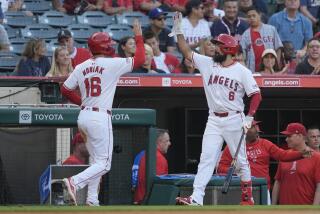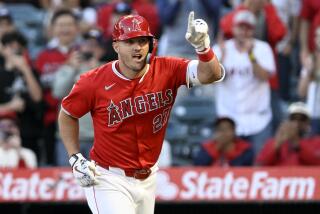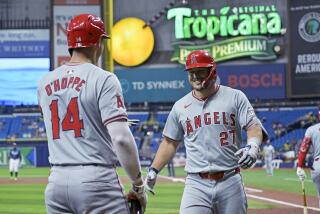SPURRING HIM ON : Donnie Moore Can Pitch With Minor Elbow Pain, but the Barbs Still Hurt
PALM SPRINGS â Donnie Moore has a bone spur in his pitching elbow. And thatâs the good news this spring.
At least itâs not in his back, where one went undetected for two years while Moore was turned into a human pin cushion, his torso a target for cortisone shots, nerve-block injections, doctorsâ probes and an acupuncturistâs needles.
At least, Moore knows what it is and why itâs there, not like the last two years, when his save totals slid painfully from 31 to 21 to 5--and no one could explain exactly why.
And itâs something Moore says he can pitch with, unlike the back spur, which turned Moore into an outpatient in uniform while his reputation around Anaheim Stadium plunged from savior to sad sack.
âI have to deal with this every spring,â Moore says. âItâs something thatâs been there for the past five or six years. It makes the elbow sore for a while but then I get the arm strong and it goes away.
âThis is nothing.â
Everything is relative, of course, and after what Moore went through in 1986 and 1987, he could lose an arm and call it nothing.
âLast year was about the toughest thing Iâve ever gone through,â Moore said. âAnd â86 wasnât a piece of cake, either. . . . They were both pretty depressing years.â
Depressing?
Imagine arriving for work every day for an entire year, sitting behind your desk and having the whole office boo every time you lifted a paper clip.
Then, imagine sitting there, eight hours straight, with a letter-opener jabbing you in the ribs.
And then listen to your boss criticize you in the next board meeting for a sudden âlack of productivity.â
Thatâs kind of how Donnie Mooreâs life has been since September 1985--the final month of his finest season as a major league relief pitcher.
It was the season that made Moore a millionaire. He had an Angel-record 31 saves, a 1.92 earned-run average, a berth on the American League All-Star team.
Then came that eerie afternoon alongside Lake Erie, that luckless day in Cleveland, when Moore inherited a 5-0 lead in the eighth inning and gave it all away, climaxed by Andre Thorntonâs home run.
The Angels lost that game--and eventually lost the American League West title, too. By one game.
A dark cloud has hovered over Moore ever since:
--Spring 1986: During a pickoff drill in the first week of training camp, Moore faked a throw to third base, twisted and threw to first. By the time the ball got there, Moore was holding his side.
âI went to the clubhouse and tried to take my shirt off,â he recalled. âI couldnât.â
--Summer 1986: Soreness in the rib cage lingered throughout the entire season. In early May, his right shoulder went bad, too, necessitating a monthlong stint on the disabled list.
âI was hurting bad,â said Moore, who labored to save 21 games, just enough to help the Angels edge out Texas for the American League West championship.
--Fall 1986: Moore threw the pitch that made Dave Henderson a hero in Game 5 of the American League playoffs, the pitch that will live in Angel infamy.
âI wasnât even supposed to pitch that day,â Moore said. âI was hurting so bad, I was going to get a couple (cortisone) shots that afternoon. I thought I was going to have a week off and get ready for the World Series. Hell, it was the ninth inning and we had a 5-2 lead.
âBut thatâs life.â
--Spring 1987: Life continued down the same course for Moore in his next training camp. Same old pain in the side, only nine innings of work before opening day.
And no real answer why the pain was there.
--Summer 1987: Tests were run, theories were forwarded, injections were prescribed--even acupuncture was tried.
Still, Moore hurt.
âWe didnât know what it was,â he said. âWe didnât know if it was a broken rib or a stress fracture or what. We looked all over and couldnât find the source of the pain.
âI had thousands of injections. I tried everything except voodoo. A lot of needles . . . and a lot of soreness.â
And a lot of boos in Anaheim Stadium. Through it all, Moore managed to pitch in just 14 games, saving only 5.
--Fall 1987: As the defending champions of the AL West collapsed, General Manager Mike Port ripped into his team for lacking heart and singled out Moore, suggesting that Moore should have been on the mound, working to help reverse the clubâs free fall through the standings.
âWhat do we pay him a million dollars for?â Port said.
Moore said: âHe said I was malingering. That hurt. That really ticked me off. Mike and I had a good exchange on the phone after that. Whatever was in my brain at the time, I spit it out.â
Mooreâs agent, David Pinter, also got a few things off his chest. He told Port to trade Moore, because his client was unwanted by the Angels and âfinished in Anaheim.â
Says Pinter now: âOf course he was unwanted. Nobody believed his injury. Why wouldnât he want out? They thought he was dogging it. They thought he was through.â
Moore stuck around long enough for another round of tests, these with a back specialist. And, finally, a bone spur, the size of a dime, was discovered at the base of Mooreâs spine.
âIt was a massive spur, very abnormal,â Moore said. âThey found it was trapping a nerve, which was causing the pain.â
Surgery was immediately prescribed, and on Oct. 5, Moore had a five-hour operation to remove the spur.
Dr. Robert Watkins performed the surgery and termed it a success.
He was not, however, able to remove all of Mooreâs pain.
âThatâs something Iâll never forget,â Moore said of Portâs get-out-there-and-pitch blast. âThat was the icing on the cake for a real tough year. Both mentally and physically, it was real tough.â
Port now refers to the incident as âmutual frustration boiling over,â attributing his comments to the heat of the moment. Port tried to make amends by visiting Moore in the hospital after the operation.
âI think they shook hands,â Pinter said. âMike tried in his own way to apologize.â
If he did, Moore has not entirely accepted the gesture.
âHe said it was more out of frustration than anything, but I still didnât like it,â Moore said. âI didnât appreciate it.
âDo you know what itâs like, coming to the ballpark every day while the rest of the team is busting their butts, trying to win a pennant, and you canât do anything but be a damn cheerleader?
âYou see (DeWayne) Buice and (Greg) Minton getting a little tired, pitching with their arms sore, and youâre thinking, âItâd be nice if I could be out there and give them a rest.â And you canât. Thatâs kind of tough.
â . . . Even if (Port) said it out of anger and frustration, heâs still responsible for his actions. Itâs like a guy going out and drinking too much and shooting his mouth off. The next day, itâs: âOh, that wasnât me. Itâs not my fault, I wasnât in the (right) frame of mind.â â
Then, there were the Anaheim Stadium fans. Every time Moore pitched at home, he went to work amid 30,000 boos.
âThat hurt, too, but not as much as the pain in my ribs,â Moore said. âThey probably didnât care about that, though. They figure, âHereâs a guy making so much money, heâs paid to go out there even with all the pain and agony.â But itâs the exact opposite. For all I went through that they didnât see, I earned every penny I got.â
The booing was a constant reminder to Moore of Henderson and the pitch that helped Game 5 get away. Despite Mooreâs exceptional 1985 season and his No. 2 ranking on the Angelsâ all-time save list--he has 57--that pitch figures to remain Mooreâs legacy.
âThatâs history,â Moore said with a sniff when asked about Game 5. âBut that pitch is not what lost that game for us. That wasnât the only chance we had to win.
âA relief pitcher (Gary Lucas) who hasnât hit a batter in four or five years goes out and hits the first batter. We had chances to score in the bottom of the ninth. . . . That was definitely a team effort, how we lost that game.â
Moore still defends his pitch selection to Henderson.
âIâve seen replays and I thought that was a damn good pitch,â he said. âIt wasnât like it was a fat pitch down the middle, a hit-me pitch. Henderson hit a damn good pitch.â
Still, the fallout from that pitch sent Moore into the 1987 season on the defensive. Once thoughtful and accommodating during interviews, Moore began snapping at reporters. He withdrew from his teammates. He scowled, he griped. He made himself unapproachable.
âFor the most part, Iâve always been a positive person,â Moore said. âLast year, I became a negative person. I walked around with a chip on my shoulder. Every little thing bothered me in a negative way.â
The situation worsened as Mooreâs inactivity increased.
âI only pitched in 14 games and it hurt just for me to throw in the bullpen. Iâd warm up in the bullpen and the next day, if felt like Iâd been beat up.
âIâd go to Gene (Mauch) the next day and say I just couldnât do it, I canât pitch. If I was in his shoes, I probably wouldâve had a funny feeling, too. Hereâs a guy who doesnât even get into a game--and heâs hurting.
âAnd the treatments only made things worse. Everything I did--exercises, shots--seemed to make it a little worse. It was kind of depressing. Things got so bad, I always seemed to be irritated, even at little things around the house.â
By seasonâs end, Moore was a man in need of a fresh start, at least in Pinterâs view. Early this year, following arbitrator Tom Robertsâ decision to emancipate the free agents allegedly victimized by the freeze-out of â85--Moore was one--Pinter tried to capitalize and see if the New York Yankees might be interested in his post-op client.
At first, there appeared to be genuine interest. General Manager Lou Piniella arranged for Moore to fly to New York for a physical and, once passing that, Moore might begin negotiations with the club.
Two days before Mooreâs flight, however, the Yankees called and canceled. After signing free agents Jack Clark and John Candelaria, they claimed, they werenât willing to take on Mooreâs $850,000 salary.
âThey knew what my salary was from the start,â Moore said. âThey knew all along what I was making.
âLou Piniella seemed pretty excited at first and then as soon as the news (of Mooreâs physical) hit the news wire, they backed off. I donât know if they were told to back off or what, but it definitely was strange.â
Pinter said: âThe owners were not too happy with the Yankeesâ $18 million payroll and I think they made that known to George (Steinbrenner). Lou Piniella was very, very much interested in taking a look at Donnie. We were all set. And then nothing. Donnie was very disappointed.â
Moore was left holding a plane ticket with nowhere to go, and no options of his own.
Except . . .
âI predict Donnie will save five games against the Yankees this year,â Pinter said. âThatâs my goal.â
Moore has another goal. He wants to make the Angels forget 1987, to rebuild partially burned bridges. Heâs in the final year of a 3-year contract. He turns 35 next February.
âIf I stay as healthy as I am now, I think I can pitch three of four more years,â Moore said. âI hope I can do it (with the Angels). Thatâd be nice, but itâs something I canât control. If I do my job and stay healthy, things will take care of themselves.â
Which brings us back to the bone spur in Mooreâs right elbow.
Moore pitched only 8 times in spring training, for 10 innings. His numbers: 0-1, a 4.50 earned-run average, 1 save, 13 hits, 3 walks, 5 strikeouts.
âIâm not holding anything back,â Moore said. âMy velocityâs getting back up there. I just need to improve my location. As long as my back feels good, and it does, I can overcome this.â
Angel pitching coach Marcel Lachemann concurs and says he speaks from experience.
âI have a bone spur so big, (Dr. Lewis) Yocum takes X-rays of it to clinics,â Lachemann said. âBut I can throw batting practice every day without a problem.
âDonnieâs got a big one, too, but thereâs no reason he canât pitch with it. The problem comes when the spur grows again or it breaks off. A lot of guys have pitched a long time with bone spurs in their arms.â
A bone spur in the back is another thing. With that problem alleviated, Donnie Moore will take his elbow spur into the season and take his chances.
More to Read
Go beyond the scoreboard
Get the latest on L.A.'s teams in the daily Sports Report newsletter.
You may occasionally receive promotional content from the Los Angeles Times.










